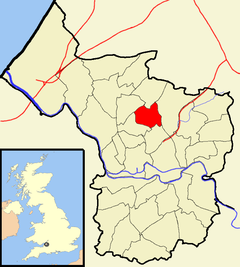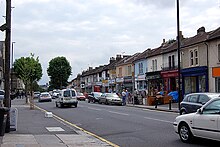This article needs additional citations for verification. (July 2024) |
Bishopston is a suburb of the city of Bristol in south west England. Bishopston is around Gloucester Road (A38), the main northern arterial road in the city and Bishop Road.
| Bishopston | |
|---|---|
 Boundaries of the Council Ward, shown within Bristol. | |
| Population | 13,871 (2011.Ward)[1] |
| OS grid reference | ST586755 |
| Unitary authority | |
| Ceremonial county | |
| Region | |
| Country | England |
| Sovereign state | United Kingdom |
| Post town | Bristol |
| Postcode district | BS7 |
| Dialling code | 0117 |
| Police | Avon and Somerset |
| Fire | Avon |
| Ambulance | South Western |
| UK Parliament | |
Bishopston is named after the bishop of the local diocese who controversially sold off the church's land to private developers in the early 19th century. The sale was even raised as an issue in the House of Commons. The parish of Bishopston was then created in July 1862 with a population of 1300 and expanding to 9140 in the 1901 census. In the 2001 census Bishopston registered a resident population of 11,996. The district is part of the Bristol built-up area, having been swallowed by the growing city, running directly into the surrounding districts of Redland, Ashley Down, Horfield and Henleaze.
The area has a relatively large student population, with 21% of the over-16 population in education compared to 8.4% in Bristol and 5.1% in England and Wales.

Some of the location filming for the cult BBC sitcom The Young Ones was done in Codrington Road and elsewhere. The external shots for the famous "bank-robbing" scene in the last episode were filmed outside the now closed Bristol North Swimming Baths on Gloucester Road.
Bishopston was the home of two Nobel Prize–winning physicists. In 1933 Paul Dirac, who attended the Bishop Road Primary School, just a few hundred metres from where he lived on Monk Road, won the prize after his contributions to quantum mechanics. In 1950 Cecil Frank Powell won the prestigious award for contributions to Physics (specifically, for his development of the photographic method of studying nuclear processes and his discoveries regarding mesons made with this method). Bishopston was home to television presenter Adam Hart-Davis and psychologist Susan Blackmore.
The famous film star Cary Grant (real name Archibald Alexander Leach) attended Bishop Road School in Bishopston. As a child he lived nearby in Hughenden Road next to Horfield Common, where there is a blue plaque to commemorate him.
Bishopston has two primary schools, St. Bonaventure's Catholic Primary School which served the huge Italian Irish and South American Catholic community and Bishop Road Primary School COE which was a secondary school up until the mid-1980s and served children of the Anglican faith and drew in children from the Asian and Jamaican community in St Paul's and Montpellier.

The main artery, Gloucester Road, is a traditional local High Street,[2] and well used by local residents. In addition to the independently run shops such as Scoopaway, La Ruca, Gardener's Patch and Harvest, recent years have seen several supermarket chains opening stores in the area, as well as a number of cafés, restaurants, and pubs. This, together with the range of fairly traded and local goods available, has made it popular with ecologically minded shoppers.
Bishopston is home to Gloucestershire County Cricket Club, located off Nevil Road. The ground's capacity has been increased to hold international cricket matches.
The David Thomas Memorial church, in neighbouring St Andrews, was erected between 1879 and 1881 but was demolished in 1987, destroying most of a Gothic fantasy by Stuart Coleman. The building still retains a thin octagonal spire and west front but the massive halls, apse and rib vaults have now gone, and have been replaced by flats by Stride Treglown.
Politics
editFor elections to Bristol City Council, it is split between the electoral wards of Redland and Bishopston and Ashley Down. The boundary between the two wards runs along Gloucester Road and then the southern perimeters of HMP Bristol and the playing fields of Bishop Road Primary and Redland Green School, with areas to the southwest in Redland ward.[3]
For elections to the UK Parliament, Redland ward is in Bristol Central constituency, and the Bishopston and Ashley Down ward is in Bristol North West constituency.
Before boundary changes in 2016, Bishopston was itself an electoral ward.[3]
Education
editBishopston is the location of Bishop Road Primary School, which opened in 1900,[4] and is the largest primary school in Bristol,[5] notable for having educated Cary Grant and Paul Dirac.[6]
References
edit- ^ "Bishopston" (PDF). 2011 Census Ward Information Sheet. Retrieved 26 February 2015.[permanent dead link]
- ^ "The last great British high street". The Independent. London. 8 August 2004. Archived from the original on 1 October 2007.
- ^ a b "Bristol". Local Government Boundary Commission for England.
- ^ "Bishop Road Primary School Inspection Report" (PDF). Ofsted. 19 May 2011. Retrieved 12 August 2012.[permanent dead link]
- ^ "Bristol's biggest primary school gets even bigger". This Is Bristol. 31 August 2009. Archived from the original on 5 May 2013. Retrieved 12 August 2012.
- ^ "Bristol celebrates Hollywood 'son'". BBC. 8 December 2001. Retrieved 12 August 2012.
External links
edit- Census data
- Photographs of Bishopston at the Geograph project
- Bristol Buddhist Centre meeting in Gloucester Road, Bishopston
- Bishopston Trading A fair trade workers cooperative.